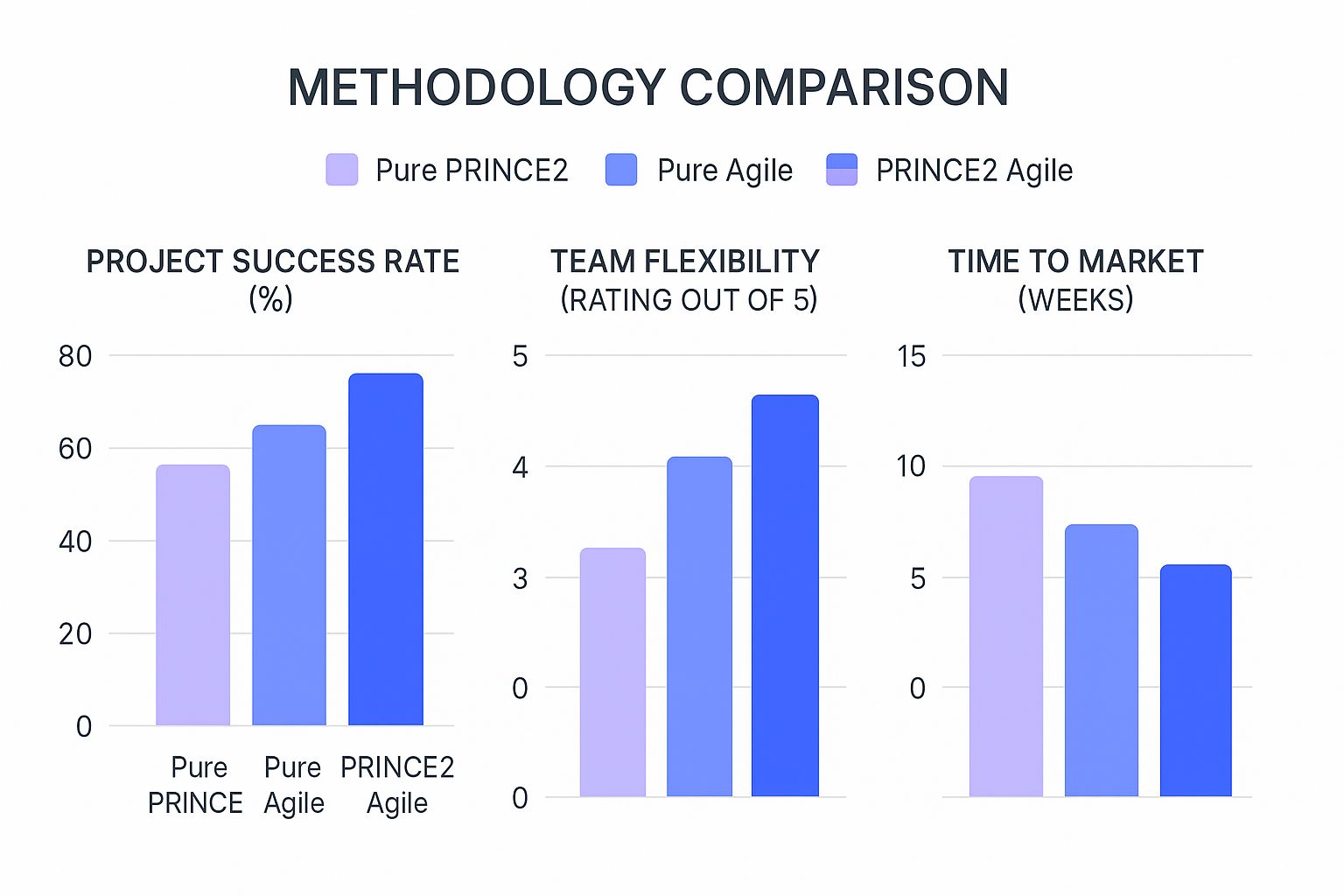A Developer's Guide to PRINCE2 Agile Foundation - App Development
A Developer's Guide to PRINCE2 Agile Foundation
Let’s be honest, the world of app development moves at a blistering pace. Trying to balance rock-solid project management with the need to be quick on your feet can feel like an impossible task. This is exactly where PRINCE2 Agile Foundation steps in, blending the trusted control of PRINCE2 with the sheer speed of Agile. It's a powerful hybrid system that’s perfectly suited for the dynamic world of Flutter app development.
Why PRINCE2 Agile Matters for UK Developers

For any developer or project manager here in the UK, the goal isn't just to build an app that works. It's about delivering it on time, on budget, and without any nasty surprises. The old-school, rigid project management styles can feel clunky and slow for software development, while going "pure agile" can sometimes feel a bit like the Wild West, lacking the high-level oversight clients and stakeholders need.
This is the gap that the PRINCE2 Agile Foundation certification fills so brilliantly. It gives you a framework that doesn't make you choose between strict control and creative freedom. You get the best of both, creating an environment that’s structured enough to be predictable but flexible enough for modern development.
A Framework Built for the UK Market
You can't talk about project management in the UK without mentioning PRINCE2. It’s been a dominant force for decades, and that widespread recognition is a huge deal. Back in 2012, over a million people had already taken PRINCE2 exams since it kicked off in 1996, with a massive chunk of them right here in the UK. You can discover more about the growth of PRINCE2 popularity and see just how big its impact has been.
What does this mean for you? It means UK clients and employers already know and trust the PRINCE2 name. When you add the agile element to it, you're showing you can manage projects with both discipline and the adaptability needed for today's market.
PRINCE2 Agile isn't about just bolting a few agile buzzwords onto the old PRINCE2 model. It’s a genuine blend, taking the proven governance of PRINCE2 and weaving it together with the responsiveness of methods like Scrum or Kanban.
For our teams at App Developer UK, this hybrid approach is non-negotiable. When we’re building complex Flutter apps, we need a system that supports rapid, iterative development and quick feedback loops. At the same time, we absolutely must have a clear structure for things like:
- Stakeholder communication: Keeping everyone in the loop, all the time.
- Risk management: Spotting potential problems before they become project-killers.
- Quality control: Making sure the final app is polished and meets our exacting standards.
Think of this guide as your complete roadmap to getting to grips with this powerful methodology.
Understanding How PRINCE2 and Agile Work Together
At first glance, PRINCE2 and Agile seem like they come from completely different planets. One is all about structure, governance, and meticulous planning. The other is celebrated for its speed, flexibility, and ability to adapt on the fly. But combining them isn't about mashing two opposing ideas together; it’s about creating a powerful synergy where each one makes the other stronger.
Think of it like building a high-performance race car. PRINCE2 is the chassis and the overall blueprint. It gives the project its core structure, defines who's accountable for what, and makes sure the whole thing has a clear direction and solid business justification. It’s the governance layer keeping everything stable and aligned with what the stakeholders actually want.
Meanwhile, Agile is the engine and the suspension system. It delivers the raw power, speed, and agility needed to handle all the twists and turns you’ll encounter on the development track. This is where the real day-to-day work gets done—in short, punchy cycles that let our teams build, test, and learn incredibly fast.
The Five Core Behaviours of PRINCE2 Agile
To make this blend truly effective, PRINCE2 Agile is built on five core behaviours that bridge the gap between high-level governance and hands-on delivery. These aren't just fluffy suggestions; they are the cultural bedrock you need for success.
- Transparency: All information, progress, and problems are laid bare for everyone to see. This builds a huge amount of trust and ensures decisions are based on what's really happening, not on guesswork.
- Collaboration: Teams work shoulder-to-shoulder, not in isolated silos. This means our developers, project managers, and clients are constantly talking and sharing ownership of the final outcome.
- Rich Communication: We favour face-to-face chats or quick video calls over long, drawn-out email threads. The aim is to get to a clear understanding and get instant feedback.
- Self-Organisation: We empower the development team to manage their own work within the agreed-upon boundaries. They're the experts at building the product, so we trust them to decide how to get it done.
- Exploration: We embrace the fact that nobody has all the answers at the beginning. The project is treated as a journey of discovery, where constant feedback and learning shape the final app.
The infographic below shows just how powerful this combination can be, highlighting its impact on key metrics like project success and team flexibility.

As the data makes clear, the hybrid PRINCE2 Agile approach consistently delivers higher success rates by beautifully balancing that essential flexibility with structured, big-picture oversight.
Adapting Principles Without Sacrificing Control
It’s a common myth that bringing Agile into the mix means tossing all of PRINCE2’s rules out the window. The reality is much smarter than that. To see how these frameworks are blended in practice, let's compare some core aspects.
Comparing Traditional PRINCE2 and PRINCE2 Agile
This table breaks down how traditional PRINCE2 components are cleverly adapted to fit a more agile, iterative workflow.
| Aspect | Traditional PRINCE2 | PRINCE2 Agile Approach |
|---|---|---|
| Project Planning | Detailed, upfront planning for the entire project lifecycle. | High-level planning with detailed planning done for each stage or sprint. |
| Management Stages | Long, sequential phases with rigid gateways. | Stages are shorter and may contain multiple iterative sprints (timeboxes). |
| Product Delivery | The final product is delivered at the end of the project. | Features are delivered incrementally at the end of each sprint, adding value sooner. |
| Change Control | Formal change request process, often seen as bureaucratic. | Change is expected and managed within sprints; the backlog is prioritised regularly. |
| Team Roles | Clearly defined roles with a hierarchical structure (e.g., Project Manager). | Blends PRINCE2 roles with agile roles like Product Owner and Scrum Master for collaboration. |
This comparison shows that PRINCE2 Agile doesn’t discard the framework's core strengths; it reinterprets them to create a more responsive system. The PRINCE2 Agile Foundation certification teaches you exactly how to tailor these principles for an agile setting. For instance, the 'Manage by Stages' principle still stands, but a stage might now consist of several two-week sprints instead of one long, six-month phase.
This integration creates a system where governance enables agility instead of restricting it. You get the freedom to iterate and adapt at the delivery level, all while maintaining the strategic control that ensures the project delivers genuine business value.
This balanced approach provides a robust framework perfect for managing complex Flutter app projects. If you want to dig deeper into the fundamentals, you can explore our resources to help you master the agile project management foundation. Ultimately, this synergy gives you a clear path forward, combining the very best of structure and flexibility.
Your Roadmap to PRINCE2 Agile Foundation Certification

Deciding to go for the PRINCE2 Agile Foundation certification is a fantastic move, especially if you’re navigating the project management scene here in the UK. It’s the qualification that shows you can walk the walk—blending rock-solid governance with the speed of agile delivery. In a fast-moving world like Flutter app development, that’s a skill set that gets you noticed.
The journey to getting certified is actually quite straightforward once you know the path. Your first step? Get familiar with the exam itself. Knowing the format inside and out means no nasty surprises on the day, letting you focus your energy where it really counts.
The Foundation Exam at a Glance
Let’s pull back the curtain on the exam. It’s designed to be a direct and honest assessment of what you’ve learned. You won’t find any trick questions here, just a clear evaluation of your grasp of the official syllabus.
Here’s a quick rundown of what to expect:
- Question Type: It's all multiple-choice.
- Number of Questions: You'll face 50 questions in total.
- Passing Score: To pass, you need to get 28 out of 50 correct, which works out to 56%.
- Duration: You’ll have 60 minutes to complete the exam.
- Exam Style: This is a 'closed book' exam, so you’ll need to rely on your knowledge—no notes or manuals allowed.
This format is purely there to confirm that you’ve truly internalised the core principles of the methodology. It’s not just about memorising facts.
The real win with this certification isn't just about passing a test. It's about building the confidence to lead projects that genuinely deliver business value. Think of the exam as the checkpoint that officially validates your new expertise.
And the impact is real. A staggering 88% of project managers with a PRINCE2 certification reported it was a major benefit to their careers. You only have to look at UK job postings to see how often it’s listed as a requirement. You can read the full analysis on the career benefits of PRINCE2 to get a better sense of its industry clout.
Choosing Your Training Path
Okay, so you know what the exam looks like. Now, how do you get ready for it? Everyone learns differently, and picking the training path that suits you is half the battle. In the UK, you’ve generally got three solid options.
- Accredited Classroom Training: This is your classic, intensive, instructor-led course, usually packed into a few days. It's perfect if you thrive on face-to-face interaction and a structured learning environment.
- Online E-Learning Courses: The flexible option. These courses let you study at your own pace with a mix of structured modules, videos, and practice exams to guide you through everything you need to know.
- Self-Study: Just you, the official manual, and other resources you can find. This route demands serious self-discipline, but it’s a brilliant, cost-effective choice if you already have some project management experience under your belt.
Each path has its own perks, and plenty of people find success with a hybrid approach, maybe pairing an online course with the official manual for deeper dives. For a more detailed look at your options, have a look at our comprehensive guide to Agile PM training in the UK.
Ultimately, the best method is the one that clicks with your learning style and gets you across the finish line with your PRINCE2 Agile Foundation certification in hand.
Applying PRINCE2 Agile in Flutter App Development

This is where the rubber meets the road—connecting the theory of the PRINCE2 Agile Foundation to the real-world challenge of building brilliant apps. For us developers in the UK, especially when we’re working with a dynamic framework like Flutter, this methodology is a game-changer. It brings a much-needed structure to our creative process.
Flutter’s speed and cross-platform muscle are its biggest strengths, but let’s be honest: without a solid plan, that speed can easily turn into chaos. PRINCE2 Agile acts as the guardrails. Think about a typical Flutter project—it’s all about rapid iterations, constant client feedback, and pressure to ship new features fast. This framework makes sure that while we’re moving quickly, we’re not just spinning our wheels. It keeps every single development sprint tied to the bigger project goals and the original business case.
In short, it’s about building the right thing, in the right way, every single time.
Structured Sprints and Clear Accountability
One of the first things you’ll notice is how PRINCE2’s 'Manage by Stages' principle gives agile sprints a proper backbone. Instead of just having a continuous, sometimes endless, series of development cycles, we group our sprints into formal management stages. At the end of each stage, the project board gets to review our progress against the plan. This is their chance to confirm the project is still on track and makes business sense.
This creates the perfect balance. The development team gets the freedom to innovate and solve problems within a sprint, while the business leaders have clear decision points without having to micromanage our daily tasks. It’s a structure that works incredibly well for Flutter projects, where recent benchmarks have shown its top-tier performance—a level of performance that is best supported by disciplined, strategic oversight.
PRINCE2 Agile gives the business-focused project board and the tech-focused delivery team a shared language. It’s how we ensure that every line of Flutter code directly serves a measurable business goal.
On top of that, PRINCE2’s focus on 'Defined Roles and Responsibilities' cuts through the noise in a fast-moving Flutter team. Roles like the Project Manager, Scrum Master, and Product Owner all have their duties clearly mapped out. This eliminates the kind of confusion that can grind a project to a halt. Everyone knows exactly who’s accountable for what, from planning the next sprint to signing off on the final delivery.
Enhancing Delivery with Integrated Processes
This structured approach has a knock-on effect that streamlines our technical work, too. When we integrate our agile sprints with proper quality checks and risk assessments, we catch bugs earlier. Potential problems get flagged before they can blow up into major headaches. This is absolutely vital when you’re aiming for the kind of slick, high-quality user experiences Flutter is famous for.
With this discipline baked into the process, our teams can focus on what they do best: building exceptional apps. This is also where modern development practices slot in perfectly. To see how this structured workflow supports automation, you might be interested in what continuous integration is for Flutter apps, as it’s a natural fit within a PRINCE2 Agile model.
Ultimately, the framework helps us deliver high-calibre Flutter applications reliably, on time, and within budget.
Real-World Benefits for Your Development Team
Bringing the PRINCE2 Agile Foundation framework into your projects isn't just about ticking a box or adding a certificate to the wall. It’s a practical move that pays real dividends across the entire team, giving everyone a shared language and a unified structure. This clarity benefits everyone from project managers to developers, and ultimately, the client.
For project managers, it introduces a welcome dose of predictability into the often chaotic world of agile development. You get the tools for solid governance and strategic oversight without having to micromanage—a practice that always kills creativity. It means you’re back in control of budgets, timelines, and scope.
On the other side of the coin, developers get the freedom they need to innovate. Within the clear boundaries set by PRINCE2, they can self-organise, collaborate, and get on with what they do best: building brilliant software. This structured freedom works especially well for our Flutter teams, letting them really push the framework’s high-performance capabilities.
Boosting Success From Every Angle
The positive effects of this blended approach create a ripple effect, fostering a team culture that’s both more resilient and more adaptive. It's not just about getting projects over the line; it’s about finishing them well and building a stronger, more capable team in the process.
- For Project Managers: You get much sharper control and a crystal-clear view of project progress. Risk management shifts from being reactive to proactive, and talking to stakeholders becomes far simpler with defined reporting structures.
- For Developers: Your team gets all the freedom of agile working without the confusion that can creep in when there’s no clear direction. With well-defined roles and responsibilities, there’s less guesswork and more time spent on quality coding.
- For Clients: They get a level of transparency that is second to none. The regular delivery of genuinely valuable features, combined with clear stage-gate reviews, builds trust and ensures the final product is exactly what their business needs.
By instilling a culture of continuous improvement, PRINCE2 Agile pushes teams to reflect on how they work at the end of each sprint. This regular look-back, the retrospective, is the key to tweaking workflows and becoming more productive over time.
This disciplined yet flexible model has a direct, positive impact on key performance metrics. In fact, studies consistently show that organisations blending agile methods with more formal project management practices report higher project success rates. By improving stakeholder satisfaction and boosting team morale, PRINCE2 Agile Foundation doesn't just manage projects—it elevates them. It lays the groundwork for consistent, high-quality delivery, making sure every single project is set up for success right from day one.
Common Misconceptions About PRINCE2 Agile
Despite its growing popularity, PRINCE2 Agile Foundation still has its fair share of myths floating around. A few persistent misunderstandings can make teams hesitant to even consider it. It’s time to clear the air and look at what this framework really is: a modern, powerful tool for getting projects over the line.
One of the biggest knocks against it? That it's just too bureaucratic for a fast-moving agile setup. People hear "PRINCE2" and immediately picture mountains of paperwork suffocating the very speed and flexibility that makes agile work. But that view completely misses the point of tailoring—the framework is a toolkit, not a straitjacket.
On a tight Flutter app deadline, for example, you’d never use the same level of documentation as you would for a massive public infrastructure project. The whole idea is to apply ‘just enough’ governance to keep things on track, ensuring your processes support delivery instead of slowing it down.
It's Not Just Old PRINCE2 with New Labels
Another common myth is that someone just slapped a few agile buzzwords onto the old PRINCE2 manual and called it a day. This couldn't be further from the truth. PRINCE2 Agile is a genuine, thoughtful integration that reworks the core principles to work in an iterative, fast-paced environment. It smartly blends the high-level project direction of PRINCE2 with the hands-on product delivery focus of agile.
A perfect example is how it handles project tolerances. Instead of being rigid about time and cost, it flips the script to protect quality at all costs, while allowing the scope to be flexible. This is a game-changer.
PRINCE2 Agile’s real strength is in providing a safety net of control and direction. This empowers agile teams to experiment, innovate, and deliver real value, all without the project spiralling into chaos.
This combination creates a system where the structure actually enables agility, rather than clashing with it. Think of PRINCE2 as the guiding strategy—the 'why'—and agile methods as the engine driving the execution—the 'how'.
Ultimately, these misconceptions usually come from not understanding the framework’s built-in flexibility. By leaning into its principles of tailoring and pragmatism, teams can get past these initial doubts. The PRINCE2 Agile Foundation gives you the knowledge to strike that perfect balance, creating a project environment that's both controlled and incredibly responsive.
Got Questions? Let's Clear Things Up
You've probably got a few questions buzzing around your head about PRINCE2 Agile Foundation. That's a good thing. It shows you're thinking about how this could really fit into your projects. Let's tackle some of the most common ones.
How Is It Different From a Pure Agile Certification?
This is a great question. While a pure Agile certification shows you’re brilliant at iterative development, PRINCE2 Agile Foundation brings something else to the table: project governance. It proves you can run an Agile project within a proper business structure—a skill that's gold dust in corporate environments, especially here in the UK.
For our Flutter developers, this is the perfect mix. They get all the creative freedom and speed of Agile, but with the guardrails of a solid framework to keep everything on track and deliver high-performance apps without any last-minute surprises.
Is It Just for Massive Projects?
Not at all. One of the best things about the framework is that you can scale it to fit the project. For smaller app developments, we simply dial back the formality and paperwork. You still get the core benefits—like control, risk management, and delivering in stages—but without the heavy-handed bureaucracy. It gives you just enough structure to keep things sane.
The real art is applying 'just enough' governance to stay in control, not drowning the team in paperwork. That’s what makes it so practical and useful for any project, big or small.
How Long Does It Take to Get Ready for the Exam?
It really depends on how you learn best, but most people find a 2-3 day accredited training course gets them most of the way there. After that, a solid week of self-study should be enough to feel confident.
If you’re going the self-study route from the start, you'll want to set aside around 20-30 hours. That'll give you enough time to really get to grips with the syllabus and run through plenty of practice exams.
Ready to see how a team that blends agility with rock-solid governance can elevate your app development? At App Developer UK, we use frameworks like PRINCE2 Agile to make sure your Flutter project isn't just good—it's a phenomenal success. Get in touch with our experts today!